Abstract
This study examined the conditions and factors affecting honey production in Hungary from the perspective of Hungarian beekeepers. Due to the scarcity of research on Hungary, this study can be considered a missing piece. The survey was based on a questionnaire survey (N = 632). Basic statistical tools (frequencies, means) were used to describe the data. To assess differences between some categorical variables, cross-stability was assessed using chi-square tests, and non-parametric tests were used. Based on the study results, the study population has an average of 101 colonies per beekeeper. Beekeepers with a low number of colonies are mainly hobby beekeepers for whom non-economic goals are a priority. The average honey yield is 40 kg per bee colony, with a wide variation between counties. The primary function of beekeeping is production and selling, followed by the importance of pollinating crops and other plants, maintaining natural landscapes and habitats, and conserving plant biodiversity. Around 80% of beekeepers keep bees primarily for income, which is consistent with production and selling as their primary activity. The main problems identified are bee mite infestation (Varroa destructor Anderson and Trueman), bee poisoning from pesticides, Nosema (Nosema apis Zander; Nosema ceranae Huang) infection, problems with sales and profitability, and lack of bee pastures.
1. Introduction
Following the initial honey-hunting, by 2450 BC, the Egyptians had developed an advanced beekeeping industry, which spread throughout the Mediterranean within the next two millennia. In the European Middle Ages, honey and wax became essential trade commodities, and beekeeping flourished [1]. Practised with rudimentary methods, beekeeping evolved in the light of scientific discoveries and developments to modern beekeeping [2]. There are more than 20,000 known bee species worldwide, of which about 12 are significant in pollinating crops. One of these, the western honey bee (Apis mellifera Linnaeus), is the most commonly kept [3], and its pollination activity increases the quantity and quality of food, thus ensuring food security [4,5]. For humanity, 90% of the benefits they provide are due to their pollination ability, and only 10% can be attributed to bee products such as honey, pollen, and beeswax [6]. According to a 2019 report, insect species at risk of extinction include pollinators such as butterflies, moths, bees, and beetles [7]. In 2020, the World Economic Forum listed biodiversity loss as one of the five most significant long-term global risks. Declining insect populations are forcing farmers to look for alternative pollination methods or switch to staple crops that do not rely on pollinators. However, these crops (e.g., rice, maize, wheat, soybeans, potatoes) are often energy-rich, nutrient-poor, and already over-consumed worldwide, contributing to an epidemic of obesity and nutrition-related diseases [8]. In addition, several factors are behind the decline in bee populations, threatening the ecosystem services they provide.
1.1. The Most Severe Problems Affecting Beekeeping and Honey Bees (Apis mellifera)
The effectiveness of beekeeping and the health of the bee population are affected and threatened by several factors. Land-use change (e.g., conversion to intensive agriculture), pesticide and fertiliser use, the spread of parasites and pathogens, predators (e.g., Asian hornet—Vespa velutina Lepeletier), nutritional stress on bees (e.g., loss of diverse pollen sources due to monoculture), and habitat loss are among the leading causes of bee population decline [9,10]. The management practices of beekeepers also have a significant influence on the damage caused by parasites and pathogens to the bee population, particularly in terms of the effectiveness of control of Varroa destructor (bee mite) [11,12,13,14]. Forage quality and pesticide exposure from surrounding land use [15], as well as weather factors, have a profound effect on forage availability, the ability of bees to regulate their winter temperature, and the time until bees can start brood rearing in spring. An analysis of bee mortality data from 2009 to 2014 showed that warmer and drier weather conditions in the previous year were associated with increased winter mortality [16]. These effects are very complex and have a significant impact on bee health. Severe weather events, such as extreme winter and summer heat, reduced rainfall, spring frosts, and drought, cause direct (e.g., scarcity of nectar and pollen sources, reduced production of honey and other bee products, and reduced pollination activity) and indirect damage (e.g., weakening and death of colonies, a high infestation of bee mites) to beekeepers [17].
As regards the profitability and economic sustainability of beekeeping, factors such as poor quality imported honey, persistently low purchase prices, or honey counterfeiting are affecting the whole sector [18,19,20]. Beekeeping is a more complex activity than a simple income source. It involves the care of bees and the relationship between the beekeeper and the bee, i.e., some beekeepers do not see their bees as a mere means of production [20]. Beekeeping is an economic activity that generates positive externalities [21] and is highly important from both an ecological and socio-economic point of view. As a hobby, it also serves recreational purposes [22].
Due to different geographic and climatic conditions, beekeeping conditions in different regions and countries can vary greatly. Spain has the highest number of colonies in Europe, with the highest colony densities in Greece and Hungary and the lowest in the northernmost part of Europe. There is also heterogeneity in the number of colonies per beekeeper. Spanish beekeepers had the highest average number of colonies per beekeeper, while British beekeepers had the lowest. Across European countries, beekeeping activities can be classified into hobby beekeepers, part-time beekeepers, and professional beekeepers. Professional beekeepers account for less than 10% of all EU beekeepers except Greece, Romania, and Spain. This high diversity also has a substantial impact on sectoral analyses [23]. Research has been carried out among European beekeepers to assess the threats to bees, the difficulties faced by the beekeeping sector, and the management practices related to beekeeping in a survey conducted between September 2021 and March 2022 [24,25,26]. Hungarian beekeepers were not involved in these studies. This research aims to fill the gap in the literature on the analysis of the Hungarian beekeeping sector by using the results of a questionnaire survey with a large sample of beekeepers nationwide. A study on the most critical problems and the COVID-19 epidemic, considered representative of the location of apiaries by county (N = 297), investigated the resilience of Hungarian beekeepers between 2015 and 2020 [27]. This study serves as a situational assessment and is the starting point for further research on the sustainability of beekeeping in Hungary.
1.2. Characteristics of the Hungarian Beekeeping Sector
The long-term trend also shows that the number of bee colonies in the EU has increased over the last decade. The number of European bee colonies (in this study, we use the term bee colony as a synonym for bee hive) was at its lowest in 2017, at 16.66 million, and then gradually increased to 17.58 million in 2018, rising to 20.046 million in 2021 and 19.89 million in 2022 [28].
According to the National Food Chain Safety Office database, in 2022, 20,945 beekeepers in Hungary managed 1.19 million bee colonies [29]. The database includes beekeepers with a registered bee colony, regardless of their number of colonies. This means that the numbers of beekeepers with a few bee colonies, hobby beekeepers, or beekeepers producing only for their consumption may distort the production data, as they are not necessarily beekeepers for commercial, income-earning purposes, and their results may not be reflected in the statistics. In addition, data such as the size of apiaries by category and the distribution of beekeepers by age, sex, and time of activity are not available in Hungary. The distribution of beekeepers by county is shown in Figure 1. Most beekeepers are located in the eastern part of the country, in Szabolcs-Szatmár-Bereg County, and in the central part of the country, in Bács-Kiskun and Pest counties, which are also among the larger counties in terms of area. The fewest apiaries are located in the capital, in Csongrád-Csanád in southern Hungary, and in Komárom-Esztergom County, which is also small in area.
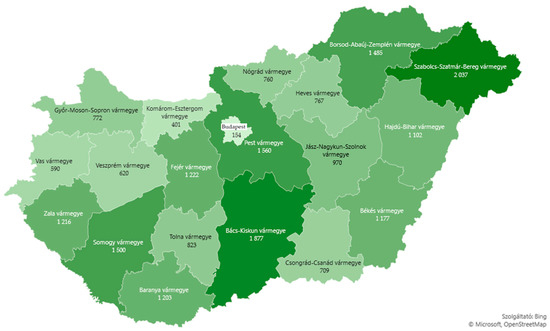
Figure 1.
Beekeepers by county in Hungary (2022) (vármegye = county).
The decline of bee colonies in Hungary has accelerated recently. The number of bee colonies has decreased from 46,886 in 2017 to 43,236 between 2019 and 2020 and 40,242 between 2021 and 2023. Consequently, bee density has also decreased, from an average of 13.44 hives/km2 in 2017 to 12.81 hives/km2 in 2022, which is still high by European standards [30]. Due to the different natural and climatic conditions in the different parts of the country and the different beekeeping traditions, the number of bee colonies per km2 in the different counties varies (Figure 2) [19,20]. In terms of the number of bee colonies, the counties with the highest number of beekeepers are in the first two places (e.g., Szabolcs-Szatmár-Bereg, Bács-Kiskun). The third place is occupied by Somogy County in Western Hungary. The counties with the fewest bee colonies are Komárom-Esztergom and Vas in the western part of the country and Pest in the western part, which has the third largest number of apiaries. A specific feature of the Hungarian sector is that relatively few beekeepers have at least 150 bee colonies. In 2017, 6.8% of beekeepers and 6.82% in 2018 had at least 150 bee colonies [31], and around 70% of beekeepers migrated to other areas to achieve higher yields [32].
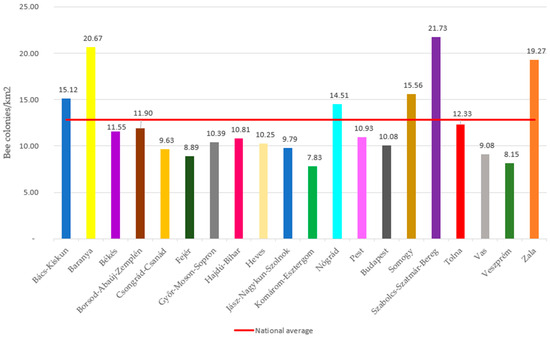
Figure 2.
Distribution of bee density by county in Hungary (2022).
More than 80% of the honey produced in Hungary is exported in barrels, typically to Western European countries [31]. Examination of export and import data has shown that Hungary has a comparative advantage in the European Union in terms of natural honey [33]. Among Hungarian consumers, acacia honey is one of the best-known and most sought-after. Since 2014, acacia honey has been a hungaricum (a hungaricum is a collective term denoting a value worthy of distinction and emphasis, which, by its characteristic, uniqueness, specificity, and quality, is the peak achievement of the Hungarian nation) [34].
Due to the global importance of beekeeping, its exposure to multiple threats, and its diversity, we consider it important to examine the conditions and factors influencing the beekeeping sector, including Hungarian beekeeping production. Through primary research among beekeepers in Hungary, we aim to map the relationships between beekeeping production practices and outcomes (honey varieties, yields), factors and motivations influencing production, and critical issues for the study population in an overall and regional (county) context. Our research focuses on honey production, as it is the primary focus of beekeeping in Hungary. The results were compared with those of similar studies to see what similarities or differences exist in the beekeeping sector from the perspective of producers in Europe.
2. Materials and Methods
2.1. Data Collection and Processing
For secondary research, the Web of Science and ScienceDirect databases were used to search the literature. Statistical data were obtained from the European Commission’s databases, the Hungarian Statistical Office, the National Food Chain Safety Office, and the Hungarian National Beekeeping Association. In Hungary, the beginning and end of beekeeping must be reported to the local government where the apiary is located and to the Breeding Information System (official register). Every year, between 15 July and 15 October, the bee colonies are inspected by an official bee health officer on behalf of an official veterinarian during a monitoring inspection in apiaries to detect bee diseases. The number of bee colonies per apiary is also recorded. Based on the checks, the authority compares the number of colonies with those declared in the Breeding Information System. It adjusts the number of colonies in case of discrepancies. The National Hungarian Beekeeping Association processes the data received from the authority as part of its inter-professional tasks. The sale of honey requires a bee health certificate issued by an official veterinarian and an official licence as laid down by law [35].
The survey was based on a questionnaire to assess the sustainability of the beekeeping sector in Hungary. A total of 632 Hungarian beekeepers were surveyed using an online and paper-based questionnaire method, with the help of the Hungarian National Beekeepers’ Association, by sharing the questionnaire among the members of the Association, the results of which are presented in this study. In this questionnaire, 39 questions were asked of Hungarian beekeepers. The present study included 12 of these questions, which concerned the factors determining the results of honey production (Appendix A). For the honey varieties produced and the yields achieved, the questions were for 2022. The questionnaire was completed online platform or on paper. The questionnaire was first validated through a pre-test with five beekeepers. The survey covered beekeepers in 19 Hungarian counties and the capital, Budapest.
The questionnaire was conducted between March 2023 and September 2024. Respondents’ participation was entirely consensual and anonymous.
According to the database of the Hungarian Beekeepers Association (2021), the sample is not representative of the apiaries’ location by county (χ2 = 107.593, df = 19, p < 0.001). Thus, the study results are valid only for the database under study. More detailed data for beekeeping in Hungary are not available.
The data were analysed using the SPSS software, version 22, supplemented by Microsoft 365 Excel 2410 version 16.0.18129.20158. Basic statistical tools, such as frequencies or mean values, were used to describe the data. Crosstabs with chi-square tests were performed to evaluate the differences between some categorical variables. Non-parametric tests Mann–Whitney U and Kruskal–Wallis were used to compare quantitative variables between two groups or three or more groups, respectively. The level of significance was 0.05 in all cases.
2.2. Weather Factors and Bee Population Conditions in 2022
Within the Hungarian National Beekeeping Programme framework, bee health and environmental monitoring studies have been carried out in Hungary since 2007. The Hungarian National Beekeeping Association publishes the results in a separate study every year [36]. According to the results of the studies for 2022, Hungary had the hottest summer in the last 100 years this year, with average August temperatures exceeding 23 degrees Celsius. This study summarises the weather impacts on the main crops (rape, acacia, linden, sunflower) related to the main honey varieties studied.
The low rainfall in autumn 2021 impacted the crops sown, especially rapeseed, which is essential for beekeeping, in spring 2022. Autumn bee pastures were drying up; some beekeepers needed food and pollen supplies to keep colonies overwinter. The winter was dry, with no rainfall. During the periodic warm-ups, bees could fly out. In 2022, an early spring was experienced, but the lack of rainfall meant crops did not develop well, except in the lower-lying areas. To avoid water shortages, it was essential to water hives inside or outside the hive. The bee colonies exploited the spring fruit blossoms after the cooling period. Lack of rainfall continued to be a problem. Rapeseed bee pastures are honeyed with varying results in different parts of the country. Rainfall occurred early in the crop’s flowering in the western counties. The results of rapeseed also depended on the nutrient supply of the fields and the performance of crop protection works at the time of crop emergence. Where conditions were ideal, honey yields exceeded 20 kg.
Unlike in previous years, in 2022, the acacia flower was not affected by frost as a weather factor, or only to a minimal extent. The acacia bloom was favourable for beekeeping in the country’s southern, eastern, local, and western parts. Subsequently, the weather conditions in Hungary’s eastern and western parts differed significantly. In the western part of the country, there was little rainfall. There was no rainfall in the east, and plants often withered before flowering. Rainfall positively affected linden forests and honey yields in the Transdanubian region.
In the case of sunflowers, the difference between the low rainfall in the west and the drought in the east was very marked. In the western counties, sunflower development in early summer was good, in contrast to the eastern counties where the crop had withered before flowering, and honey yields were lower than in the past, except in irrigated areas. The drought conditions necessitated supplementary feeding of bee colonies and pollen supplementation in August. The heat continued into September, with rainfall appearing in the country in the middle of the month. The flowering of late autumn greening did not stop the brood of bee colonies. This makes effective control of the Varroa mite very difficult, with severe consequences for the overwintering of bee colonies.
3. Results and Discussion
3.1. Sample Characterisation
Table 1 shows a sociodemographic characterisation of the sample. Some participants did not fill in the questions for each variable, so the description of sociodemographic characteristics refers to the item numbers in the table.

Table 1.
Sociodemographic characterisation of the sample.
Regarding age, participants were categorised as follows: young (up to 30 years old), middle-aged (between 31 and 59 years old), and senior (60 years or over). The distribution by age was 33 young respondents, 293 middle-aged respondents, and 137 seniors.
In terms of country distribution, Bács-Kiskun was the country with the highest percentage of young adults (20%), while Komárom-Esztergom and Vas had the highest percentages of senior adults (65% and 57%, respectively). In other countries, the average age of beekeepers is also high, ranging from 42 to retirement age. The oldest beekeepers are in France, Italy, Ireland, Scotland, and Sweden, while in Malta, most beekeepers are in the 41–50 age group [26,37].
Participants were classified by educational level into the following categories: primary (elementary school), secondary1 (vocational), secondary2 (high school), and university (tertiary). The distribution by educational level was 4 primary, 112 secondary1, 186 secondary2, 154 universities, and 7 with no response. For all counties, the highest proportions are in the secondary2 and university categories. Budapest (67%) and Hajdú-Bihar (65%) have the highest proportions of secondary education2, while university education is the most common in the Transdanubian counties of Tolna (86%), Veszprém (56%), and Somogy (53%).
3.2. Characterisation of Beekeeping Activity in Hungary
3.2.1. Number of Beekeepers and Bee Colonies Surveyed
Respondents who provided the number of bee colonies they manage were fewer than the sample size (N = 613), as many considered it sensitive data and did not wish to comment (Table 2). The results show that the average number of bee colonies per respondent is 101 bee colonies per beekeeper, which is the highest in Hajdú-Bihar County (142 bee colonies per beekeeper) based on the distribution of responses, similarly high in the counties of Csongrád-Csanád (133 bee colonies per beekeeper), Borsod-Abaúj-Zemplán (119 bee colonies per beekeeper), Baranya (116 bee colonies per beekeeper), and Somogy (116 bee colonies per beekeeper). Among the respondents, Budapest’s average number of bee colonies is significantly lower (19 bee colonies per beekeeper). This may be because the beekeeping statistics treat the data for the capital as a separate unit, which is also smaller in terms of area compared to the other counties. In Hungary, beekeepers typically keep 20 bee colonies as a hobby and over 20 for supplementary income (more than 70% of beekeepers fall into this category) [38]. In the EU, 3% of beekeepers [39], and in Hungary, nearly 7% of beekeepers work with more than 150 colonies, which falls into the category of professional beekeeping [33]. The survey results reflect this high share of hobbies and extra income sources.

Table 2.
Regional distribution of beekeepers and bee colonies based on responses.
The average number of bee colonies per beekeeper varies considerably between countries. According to a survey of European beekeepers carried out between September 2021 and May 2022, the average number of bee colonies per beekeeper in Spain is 180, in Greece 135, in Portugal 131, in Romania 98, in Italy 88, in Ukraine 70, while in France 30, in Slovakia 22, and in Germany 19 bee colonies per beekeeper were found among the surveyed beekeepers. This suggests that the Mediterranean countries and Eastern Europe have the most significant number of beekeepers, with a colony size of between 70 and 131, reflecting the part-time character of beekeeping. This is true for almost all Icelandic respondents, more than three-quarters of Scots, and two-thirds of Irish and Swedish respondents. At the same time, small hobby beekeeping was the most common in the western countries. In northern Europe, the majority of beekeepers have fewer than 10 bee colonies [26]. According to the results of this study, the average number of bee colonies in Hungary is 101. A survey of beekeepers in Malta found that 35% of beekeepers manage between 10 and 50 bee colonies, just under 14% manage 50 bee colonies, and no beekeeper surveyed had more than 200 bee colonies [37].
3.2.2. Honey Types and Yields
According to the literature and statistical databases, production (quantity) data are collected for natural honey, and there are no precise data on honey type. Therefore, the research also assessed the type of honey produced in Hungary by county and for the sample as a whole. This depends to a large extent on the location of natural and cultivated plants requiring insect pollination.
For the question on the types of honey produced by beekeepers, respondents were asked to indicate the types of honey produced during the period under study and the yields per bee colony. The types of honey included acacia honey, rapeseed honey, sunflower honey, linden honey, mixed flower honey, and other types of honey (e.g., chestnut, false-indigo, scorpionweed, wild tobacco, pine). Despite the great diversity of types of honey, acacia honey is the honey produced in the highest proportion (Figure 3). Acacia honey is followed by sunflower and rapeseed honey. The production of these honey varieties is the most significant. This result is in line with the fact that in Hungary, the contiguous acacia forests are high by European standards and that acacia honey is one of the most essential honey produced in Hungary [19]. The purchase and sales prices of this type of honey are also higher than those of other honey [19,20,38]. In Hungary, the proportion of Robinia pseudoacacia in managed forest areas is the highest (nearly 460 thousand hectares, about 24%) of all tree species [40,41]. The largest areas of acacia forests are found in the counties of Szabolcs-Szatmár-Bereg, Nógrád, Borsod-Abaúj-Zemplén, Baranya, Somogy, Zala, Pest, and Bács-Kiskun. The size of the Tilia plathyiphylos and Tilia cordata forests is small, 1.3% of the total area of Hungarian forests, and they are mainly found in the southern Transdanubian counties, such as Somogy, Baranya, and to a lesser extent in Zala. Sunflower and rape are among the most important Hungarian arable crops and important bee pastures. In Hungary, the arable land is about 4163 thousand ha, most of which is located in the counties of Bács-Kiskun, Hajdú-Bihar, Békés, and Jász-Nagykun-Szolnok, depending on the production area. In 2022, rapeseed cultivation declined slightly, with an area of 209 thousand hectares, 52 thousand hectares less than a year earlier. In Vas County, the most important county for rapeseed production, the area under rapeseed decreased slightly. Sunflower, the most important oilseed crop, was cultivated on about 700 thousand hectares in 2022, 5.8% more than a year earlier. Almost 14% of this area was in Jász-Nagykun-Szolnok County [42].
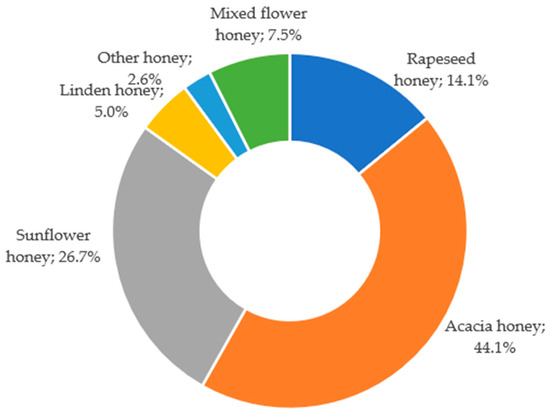
Figure 3.
Distribution of honey yields.
Based on both the total sample and the distribution by county, acacia honey is the primary honey produced everywhere, followed by sunflower and rapeseed honey (Figure 4). In some counties, such as Csongrád-Csanád, Győr-Moson-Sopron, Somogy, Vas, Veszprém, and Zala, rapeseed honey accounts for a larger share than sunflower honey, given their area under cultivation. For linden honey, higher yields are found in counties with larger contiguous linden forests or close to them, such as Somogy, Komárom-Esztergom, Zala, Baranya, and Budapest counties. In Fejér County and Budapest, mixed flower honey is also significant for the responding beekeepers.
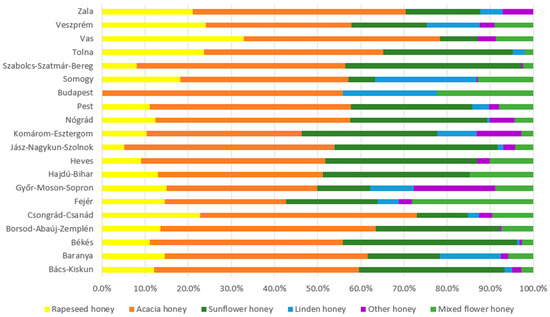
Figure 4.
Distribution of honey types by county based on average yield.
According to the European Union report, based on the report prepared for the national beekeeping programmes of the Member States, the total honey yield in Hungary was 21 kg/bee colony in 2018, which is similar to the EU average (22 kg/bee colony) [43]. Based on their comments in the questionnaire, it should be noted that most beekeepers keep the honey yield data confidential and do not wish to provide it. Compared to the European average, the beekeepers surveyed reported higher honey yields, as shown in Figure 5, by main honey types, by county, and for the total respondents. This shows that all counties have the highest acacia honey yields, except three (Veszprém, Heves, and Csongrád-Csanád), but all exceed 21 kg/bee colony. The highest value is found in Bács-Kiskun (46.92 kg/bee colony). This result confirms the importance of acacia honey for Hungarian beekeepers. According to the survey, the highest honey yields (aggregated by honey type) were recorded in the counties of Somogy (77.89 kg/bee colony), Hajdú-Bihar (68.64 kg/bee colony), Békés (49.82 kg/bee colony), and Budapest (49.29 kg/bee colony). The lowest total honey yield was in Fejér (24.68 kg/ha), but even there, it exceeded the previous EU average.
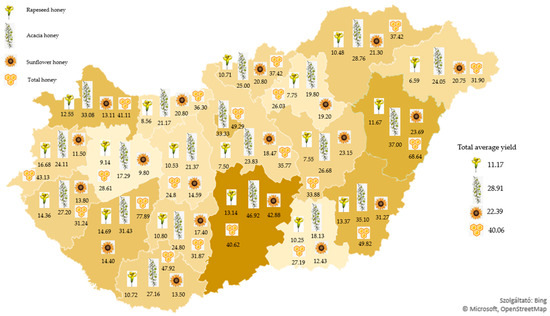
Figure 5.
Average honey yield by total and main honey types (kg/bee colony).
Based on a study with 300 hives modelling migratory beekeeping in Hungary, the total honey yield is 60 kg/beehive (acacia honey 21 kg/beehive; rapeseed honey 10 kg/beehive; sunflower honey 19 kg/beehive; mixed flower honey 19 kg/beehive), assuming a beekeeping season free of extremes (e.g., weather, selling problems, bee health issues) [44]. Compared to other countries where only the total honey yield (not by honey type) is available, the average honey yield per beekeeping year in Ukraine and Romania is 37.8 kg/bee colony and 33.2 kg/bee colony, respectively, and 22.9 kg/bee colony in Slovakia. According to 2017–2018 data, the average honey yield was 21.4 kg per bee colony in Germany, 14.4 kg per bee colony in Greece, 12.1 kg per bee colony in Portugal, 15.6 kg per bee colony in Spain, 16 kg per bee colony in Italy, 15.8 kg per bee colony in France, while the European average was 22 kg per bee colony [26]. This research also emphasises that these data refer only to the regions studied, are based only on the declarations and estimates of beekeepers, and are indicative. The results of the various surveys are primarily based on local experiences and specificities, which makes it challenging to generalise nationally or within a region. Beekeeping seasons may differ in the development of factors influencing honey production (e.g., weather, bee health, market conditions). Nevertheless, it is considered appropriate to present the most recent survey results.
Research on the impact of climate change on honey yields shows that honey beekeepers in the highly affected by climate change category (Southern and Eastern Europe) experience significantly lower average honey yields of 14.9 kg/bee colony compared to 18.3 kg/bee colony for beekeepers, not in the highly affected by climate change category (Northern and Western Europe). The proportion of beekeepers reporting honey yields above the EU average (i.e., >21.0 kg/bee colony) was 19.4% among beekeepers in the highly affected category compared to 30.0% of beekeepers not in this category [24].
3.2.3. Assessment of the Benefits of Beekeeping
The question of how beekeepers perceive the benefits and advantages of beekeeping was answered by ranking the provided answer options. The answers included the production and sale of bee products, pollination of crops (e.g., sunflowers, rape), pollination of other crops (e.g., wildflowers), conservation of natural landscapes, habitat conservation, knowledge raising, and maintenance of plant biodiversity. The responding beekeepers ranked honey production and selling first, followed by crop production and pollination of other plants. In fourth to fifth place, respondents ranked the importance of maintaining natural landscapes and habitats and plant biodiversity through beekeeping in equal proportions. Respondents considered knowledge dissemination the least important function (Figure 6).
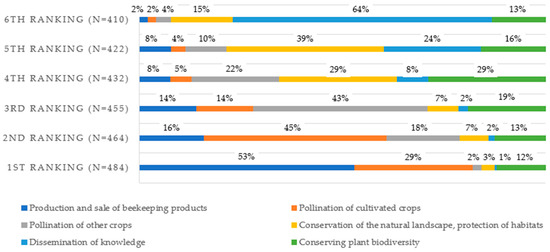
Figure 6.
Evaluation of the benefits of beekeeping.
The benefits of beekeeping by county and for respondents as a whole were ranked first for honey production, followed by pollination and the importance of plant biodiversity. The results of the ranking of respondents by county are shown in Figure 7. The red line represents the percentage of all respondents (total sample, N = 484) who ranked the factor (production and sales of beekeeping products) as the first.
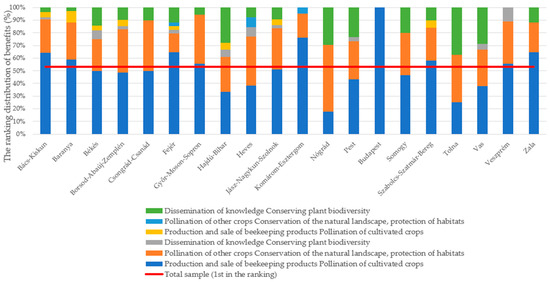
Figure 7.
Ranking the benefits of beekeeping by county.
Several studies have proven the benefits of beekeeping. Honey bees and beekeeping generate many benefits that can be grouped into three main interrelated groups or dimensions: environmental, socio-economic, and socio-cultural [21]. In terms of ecosystem service benefits, a questionnaire survey in the Czech Republic showed that the most important benefits were the pollination of crops and other plants (54.7%) and the production of bee products (24.8%) [6]. The role of bees in pollination and biodiversity maintenance is also reflected in their ability to contribute to 15 of the 17 UN Sustainable Development Goals (SDGs) [45]. The impact of insect pollination on crop yields in oilseed rape and sunflower is considerable (about 30% for oilseed rape and 40% for sunflower) [46,47]. From an economic point of view, the main purpose of beekeeping is the production of honey and other beekeeping products; it provides beekeepers with income and livelihood opportunities, it generates significant export revenues, as most of the Hungarian honey is exported abroad, and thus plays a role in the development of macroeconomic indicators and rural employment [19,44]. Honey and other beekeeping products also play an important role in providing society with healthy, high-quality food [48].
3.2.4. Personal Motivations for Beekeeping
The evaluation results of the benefits of beekeeping are consistent with the answers to personal motivations for keeping bees. In Hungary, the proportion of professional beekeepers is low, with the vast majority keeping bees as a supplement to their income or as a leisure activity. According to the aggregated results of the survey, about 80% of the beekeepers surveyed keep bees primarily for income, but beekeeping as a hobby (38.3%) and to continue family traditions (25.8%) are important motivations, followed by the production of products for personal consumption (21.4%). This question allowed for multiple answers, where, in most cases, the hobby or love of bees was also mentioned in addition to income. In addition to producing products for personal consumption, the other category that could be recorded as a separate answer was the love of bees (3.2%).
The distribution of personal motivations by county is in line with the aggregated results, with the primary motivations being to earn an income from beekeeping, spend leisure time, continue traditions, and produce honey for personal consumption. Figure 8 shows a distribution by county of the percentage of respondents who identified each of these factors as their motivation for beekeeping. The highest percentage in each county cited earning an income as a motivation. However, some overlap exists, as respondents could have identified multiple factors as motivation. In addition to earning an income, hobbies were the most commonly cited motivating factor.
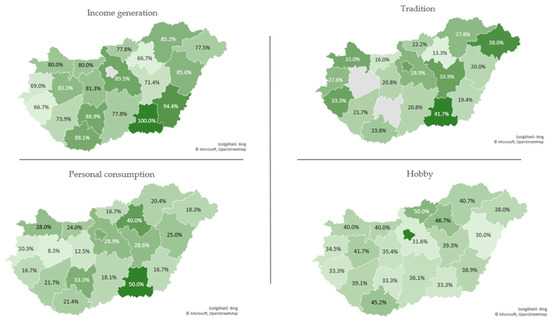
Figure 8.
Personal motivations for beekeeping by county (N = 632).
In Ukraine, Portugal, Greece, Romania, and Northern Cyprus, 40–50% of respondents and in Sweden, one-third of respondents cited financial considerations as a reason for their beekeeping activity. However, for a significant proportion of them, it is a source of extra income. For respondents with less than 5 years of beekeeping experience, harvesting honey and sharing it with loved ones was a motivation. For 74% of Icelandic respondents, honey production motivates beekeeping [26]. A qualitative study on beekeeping decision-making found that beekeepers’ intrinsic motivation is a sense of love and responsibility for bees, a sense of the importance of pollination, and, depending on the size of the apiary, the fact that it remains a hobby in addition to earning a living or supplementing income [20].
3.2.5. Transhumance of Bee Colonies
The survey included whether beekeepers migrate their bee population during the beekeeping season. The purpose of migrating is to allow beekeepers to find a natural food source for their bees to match the flowering season, increasing honey production yields. Plants are essential for honey production, and flowers are produced at different times, and beekeepers need to plan their migration accordingly [19]. This is increasingly complicated by the simultaneous flowering of plants due to extreme weather conditions. This is a crucial issue for beekeeping practice, as it can potentially increase yields. However, it is costly, requires transport vehicles, and exposes bee populations to various threats such as disease, parasite infestation, and pesticide poisoning. According to a survey by the Hungarian Statistical Office in 2012, about 70% of Hungarian beekeepers migrate to different beekeeping sites to achieve higher yields [31]. According to the aggregated data of the present survey, more than half (59.3%) of the responding beekeepers regularly migrate their bee population.
According to the results by county, the proportion of beekeepers who regularly migrated their colonies was highest in the eastern part of the country, mainly in the counties of Hajdú-Bihar, Bács-Kiskun, Jász-Nagykun-Szolnok, Békés, and Csongrád-Csanád (Figure 9). The average number of bee colonies was also high in these countries. It should be noted that questionnaire completion from these counties was higher.
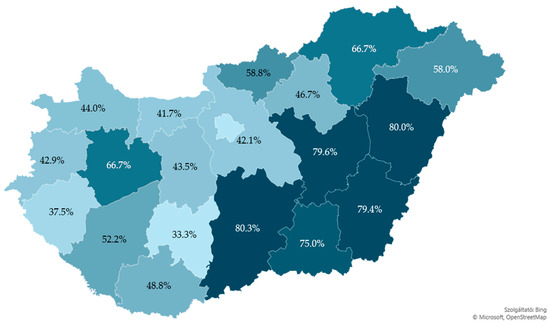
Figure 9.
Distribution of transhumance of honey bee colonies by county (N = 619).
3.3. Assessment of Problems in Beekeeping
The question of the most critical problems for the respondents’ beekeeping was answered by ranking at least five possible answers. The problems identified in the questionnaire, based on the literature, were pathogens (e.g., Nosema; American foulbrood (Paenibacillus larvae) White; Chalkbrood (Ascosphaera apis) L.S. Olive and Spiltoir; Sacbrood virus White) and parasites that threaten bee health (e.g., Varroa destructor), poisoning caused by pesticides, technological or application errors, damage caused by other animals (e.g., bee-eater (Merops apiaster Linnaeus); Asian hornet (Vespa velutina); Death’-head hawkmoth (Acherontia lachesis Linnaeus), and other categories where the respondents could also provide their answers. The ranking of problems was based on a weighted arithmetic mean, with a value of 1 being the most important problem. The Varroa destructor was identified as the biggest problem, followed by bee poisoning from pesticides and then Nosema (Figure 10). Among the problems identified in the other categories, problems with sales and profitability and lack of bee pastures were highlighted.
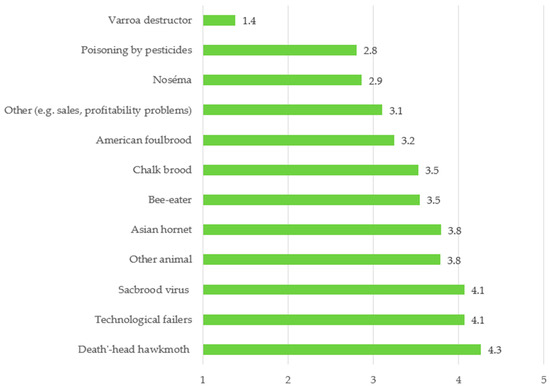
Figure 10.
Ranking the problems of beekeeping (N = 632).
The ranking of the problems by county resulted in a similar ranking to the aggregated ranking (Figure 11). These three problems are examined in more detail below, and Varroa destructor, Nosema, and poisoning are highlighted in the responses.
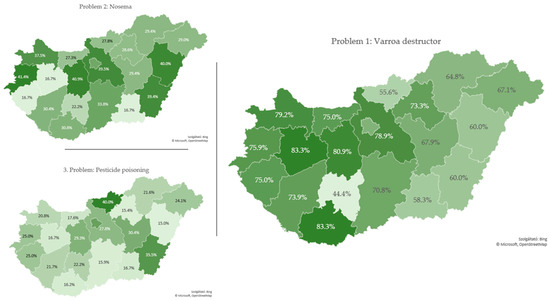
Figure 11.
Ranking the main problems of beekeeping by county (N = 632).
Consistent with our results are studies showing that Varroa destructor infection was by far the most correlated variable with winter mortality rates [49,50,51,52], followed by temperature conditions, beekeeping practices, potential pesticide exposure, and landscape connectivity [51]. European beekeepers consider that, in addition to the threat of parasites (e.g., bee mites), the most significant damage is caused by the spread of agricultural pesticides and predators (e.g., Asian hornet) [26]. Research in Western Balkan countries (Serbia, Montenegro, Bosnia and Herzegovina, Northern Macedonia, Albania, and Kosovo) has shown that climate change is the most significant threat to beekeeping, followed by loss of vegetated areas (cutting of honey perennial crops and deforestation) [25].
Other research has shown that the biggest problem for beekeepers is the quantity and quality (lack of) of bee pastures, which are the basis of production and a natural food source for bees. In addition, the negative effects of climate change, the adverse effects of pesticides [20,53,54], diseases and pests [55,56], and the high winter bee losses as a consequence of all these [57] are critical problems. Other research reports poor quality imported honey, low buying and selling prices, climate change, inadequate spraying, bee diseases, lack of cooperation, high bee density, and various damage events as the most critical negative factors [27].
3.4. Analysis of Correlations
3.4.1. Factors Correlated with the Size of the Apiary
The size of the beekeeper, i.e., the number of hives, was examined in terms of type of activity, professional experience, and number of generations of beekeepers (Table 3, Table 4 and Table 5).

Table 3.
Correlation between the apiary size and the type of activity.

Table 4.
Correlation between apiary size and generation.

Table 5.
Correlation between apiary size and professional experience.
The average number of colonies is significantly higher for full-time beekeepers (K-W, p = 0.000). In this case, the average number of colonies is 171, representing professional, large-scale beekeeping, where the activity is the beekeepers’ livelihood [44].
For respondents who were first-generation beekeepers, the average number of colonies was significantly lower (K-W, p = 0.000). A study based on interviews with beekeepers found that the vast majority of beekeepers were introduced to bees at a young age, mainly through family ties, and were involved in beekeeping activities at an early age [20]. Consequently, with more experience, they can confidently keep a larger colony of bees.
According to the survey, the more years of professional experience a beekeeper has, the higher the average number of colonies (K-W, p = 0.000). Ten years in beekeeping can be enough learning and capitalisation time for beekeepers to increase colony numbers significantly [38]. Professional knowledge and experience are essential to continue good beekeeping and bee health practices. More than 73% of responding beekeepers have more than 10 years of professional experience, similar to European beekeepers, whose average is 12 years [26]. In Northern and Western Europe, beekeepers consider patience and calmness as the essential qualities of a “good beekeeper”, while in Southern Europe, passion for bees is the main driver of success. According to them, before starting beekeeping, one should think, seek a mentor, and always strive to learn about bees [58].
3.4.2. Factors Related to Transhumance
Concerning transhumance and realised honey yields, we investigated whether there is a difference in the average yields of the six main honey varieties regarding whether beekeepers transhumance the honey bee population. We used the non-parametric Mann–Whitney U test with a 5% significance level (Table 6).

Table 6.
The difference between transhumance and honey types.
There is a significant difference (p < 0.05) between the average yields of acacia honey and sunflower honey and the transhumance. In the apiaries where transhumance was carried out, higher average yields were obtained for acacia and sunflower honey. However, this difference may also be due to the high standard deviation. Both bee pastures represent large areas, so migration to them by beekeepers is more intensive. Furthermore, the difference for mixed flower honey is significant (p = 0.051), where the lower yield is observed in the case of transhumance. This can be explained by the fact that beekeepers do not take part of the mixed honey from the migrating hives to keep it as natural food in the hives, thus reducing unnecessary feeding and the cost of honey harvesting.
We also found a correlation between the amount of professional experience in beekeeping and migration (χ2 = 15.161, df = 3, p = 0.002). Those with 5–10 years or more of professional experience are more likely to migrate their bees than those with fewer years of professional experience. Regarding the qualification of the surveyed beekeepers, an agricultural vocational qualification was also associated with transhumance (χ2 = 17.196, df = 3, p = 0.001). Beekeepers with a vocational qualification are likelier to visit other bee pastures with their bees than those without such a qualification. Around 76% of Hungarian beekeepers do not have a beekeeping qualification [38], possibly due to the large number of hobby and part-time beekeepers.
3.4.3. Factors Correlated with Beekeepers’ Motivations
For the personal motivations of beekeepers, we examined whether motivations were related to the generation of the respondent beekeeper and the type of beekeeping (full-time or part-time) (Table 7).

Table 7.
Correlation of motivations between generations and forms of activity.
Regarding income earning as a motivating factor, significant differences were found by type of activity (χ2 = 35.669, df = 3, p = 0.000), i.e., income earning as a motivating factor was higher for full-time beekeepers (those who only beekeepers).
Significant differences were found in the motivational factor of beekeeping as a continuation of family tradition by generation (χ2 = 169.327, df = 4, p = 0.000), meaning that a higher percentage belong to the third-generation or more beekeepers group. Similarly, significant differences were found for the hobby as a motivating factor (χ2 = 28.263, df = 4, p = 0.000), meaning that a higher percentage of beekeepers are beekeepers in the generation 3 and above and beekeepers who are engaged in beekeeping as a complementary activity to other work (χ2 = 24.264, df = 3, p = 0.000).
4. Conclusions
The research investigated the characteristics of the honey production environment in Hungary and the factors influencing beekeepers from the perspective of beekeepers. There is limited research in this field in Hungary, so this study is considered a missing piece. The theoretical framework of the research was provided by a secondary research literature analysis, during which the most critical problems and production characteristics were identified. In the primary research framework, the results of a national questionnaire survey were processed using quantitative methods.
For the Hungarian beekeepers surveyed, the average number of bee colonies per apiary was 101 hives, with the highest distribution of responses in the eastern part of the country, Hajdú-Bihar County (142 bee colonies), and the lowest in Budapest (19 bee colonies).
Most beekeepers keep data on honey yields confidential based on their comments in the questionnaire. Among the respondents, acacia honey yields are the highest in all but three counties. Acacia honey is indispensable for Hungarian beekeepers, and its selling price is higher than other honey varieties. According to the survey, the average yield for all honey produced is 40 kg per bee colony. There is a wide variation between counties, with the highest in Somogy County (78 kg/bee colony) and the lowest in Fejér County (25 kg/bee colony).
The primary function of beekeeping, according to the research, is production and selling itself, followed by the importance of pollination of crops (e.g., sunflower, rape) and then pollination of other plants (e.g., wildflowers). Respondents considered conserving natural landscapes, habitats, and plant biodiversity through beekeeping less critical. Respondents considered the dissemination of knowledge to be the least essential function. Around 80% of beekeepers are primarily for income, with production and sales being the primary motivation.
Among the respondents, the practice of transhumance beekeeping is most widespread in the eastern part of the country, mainly in the counties of Hajdú-Bihar, Bács-Kiskun, Jász-Nagykun-Szolnok, Békés, and Csongrád-Csanád. In the apiaries where migratory beekeeping was practised, higher average yields were obtained for acacia and sunflower honey. The results obtained show several similarities with the beekeeping sector in other European countries, such as the size of apiaries, the ageing of the beekeepers’ population, the perception of beekeeping as a leisure activity rather than an economic one, the importance of professional knowledge, the maintenance of biodiversity and the sense of responsibility for the care of bees. The challenges facing the sector and bees are similar in several respects, such as Varroa destructor, diseases, bee poisoning from pesticides, weather extremes, declining natural food sources for bees, and problems in the honey market. Untrained beekeepers without adequate knowledge can pose an additional risk to other beekeepers, which makes professional training very important [20].
An ageing beekeeper society, low professional skills, and a wide range of problems affecting beekeeping (e.g., climate change, bee health, market situation) raise serious questions about the sustainability of beekeeping, which justifies the need for further research. Our results can be used as a starting point for further research on the situation of the beekeeping sector, for the appropriate design of support policies, and for evaluating the effectiveness of existing measures. We plan to extend the research to a broader range of beekeepers in Hungary for further analysis. Effective statistical data collection is needed to provide comprehensive, multi-year data at the national level to support the analysis of the sector. Compulsory statistical reporting by beekeepers could be integrated into applying for subsidies.
A limitation of the study is that the survey is not representative and does not characterise the whole beekeeper population. The survey covered the year 2022, and it should be noted that the performance of individual beekeeping seasons may vary significantly (e.g., due to weather, condition of the bee population, and availability of beekeepers). Furthermore, only data on honey production were considered in this study.
Author Contributions
Conceptualisation, A.B.G. and I.S.; methodology, A.K.S.; software, A.K.S.; validation, A.B.G. and I.S.; formal analysis, A.F.F.; investigation, A.F.F., A.B.G. and A.K.S.; resources, A.F.F.; data curation, A.F.F. and A.K.S.; writing—original draft preparation, A.F.F., A.B.G. and A.K.S.; writing—review and editing, A.F.F. and A.B.G.; visualisation, A.K.S.; supervision, I.S.; project administration, A.F.F.; funding acquisition, A.F.F. All authors have read and agreed to the published version of the manuscript.
Funding
Supported by the EKÖP-24-3 University Research Scholarship Program of the Ministry for Culture and Innovation from the source of the National Research, Development and Innovation Fund. The APC was funded by the University of Debrecen Program for Scientific Publication.
Institutional Review Board Statement
Not applicable.
Data Availability Statement
Dataset available upon request from the authors. The raw data supporting the conclusions of this article will be made available by the authors on request.
Acknowledgments
Thanks to all beekeepers who contributed to this research by completing the questionnaire. Thanks to the National Hungarian Beekeepers’ Association for coordinating the completion of the questionnaire.
Conflicts of Interest
The funders had no role in the design of the study; in the collection, analyses, or interpretation of data; in the writing of the manuscript; or in the decision to publish the results.
Appendix A
The questionnaire questions are listed below:
- Please indicate what is your personal motivation for keeping bees?
- Current number of bee colonies:
- Please rank which are the biggest problems in your beekeeping? Please indicate at least five answers!
- In which county in Hungary is your permanent apiary located?
- Do you regularly transhumance your bee colonies?
- Please indicate the honey yield (kg per colony) per honey variety for 2022?
- Please rank the benefits of beekeeping in Hungary!
- Your age:
- Which generation do you belong to?
- What form does your beekeeping take?
- How many years of experience do you have?
- What is your highest level of education?
References
- Kritsky, G. Beekeeping from Antiquity Through the Middle Ages. Annu. Rev. Entomol. 2017, 62, 249–264. [Google Scholar] [CrossRef] [PubMed]
- Şen, F.; Halvacı, E.; Kozak, T.; Gül, M.; Kars, H.; Bayat, R. Journey to the Sweet World of Beekeeping: Historical Development, Honey Harvesting and Overview of Bee Products. JSR-B 2024, 9, 39–58. [Google Scholar]
- Potts, S.; Biesmeijer, K.; Bommarco, R.; Breeze, T.; Carvalheiro, L.; Franzén, M.; González-Varo, J.P.; Holzschuh, A.; Kleijn, D.; Klein, A.-M.; et al. Status and Trends of European Pollinators. Key Findings of the STEP Project. Available online: http://step-project.net/img/uplf/STEP%20brochure%20online-1.pdf (accessed on 30 September 2024).
- FAO. The Power of Pollinators: Why More Bees Means Better Food. 2016. Available online: https://www.fao.org/news/podcast/tzh-06-the-power-of-pollinators-why-more-bees-means-better-food/en/ (accessed on 10 September 2024).
- Garibaldi, L.A.; Carvalheiro, L.G.; Vaissière, B.E.; Gemmill-Herren, B.; Hipólito, J.; Freitas, B.M.; Ngo, H.T.; Azzu, N.; Sáez, A.; Åström, J.; et al. Mutually Beneficial Pollinator Diversity and Crop Yield Outcomes in Small and Large Farms. Science 2016, 351, 388–391. [Google Scholar] [CrossRef] [PubMed]
- Vrabcová, P.; Hájek, M. The Economic Value of the Ecosystem Services of Beekeeping in the Czech Republic. Sustainability 2020, 12, 10179. [Google Scholar] [CrossRef]
- Sánchez-Bayo, F.; Wyckhuys, K.A.G. Worldwide Decline of the Entomofauna: A Review of Its Drivers. Biol. Conserv. 2019, 232, 8–27. [Google Scholar] [CrossRef]
- World Economic Forum. The Global Risks Report 2020, 15th ed.; World Economic Forum: Cologny, Switzerland, 2020; Available online: https://www3.weforum.org/docs/WEF_Global_Risk_Report_2020.pdf (accessed on 10 October 2024).
- Becher, M.; Osborne, J.; Thorbek, P.; Kennedy, P.; Grimm, V. REVIEW: Towards a Systems Approach for Understanding Honeybee Decline: A Stocktaking and Synthesis of Existing Models. J. Appl. Ecol. 2013, 50, 868–880. [Google Scholar] [CrossRef]
- Lambert, O.; Piroux, M.; Puyo, S.; Thorin, C.; L’Hostis, M.; Wiest, L.; Buleté, A.; Delbac, F.; Pouliquen, H. Widespread Occurrence of Chemical Residues in Beebee colony Matrices from Apiaries Located in Different Landscapes of Western France. PLoS ONE 2013, 8, e67007. [Google Scholar] [CrossRef]
- Genersch, E.; Von Der Ohe, W.; Kaatz, H.; Schroeder, A.; Otten, C.; Büchler, R.; Berg, S.; Ritter, W.; Mühlen, W.; Gisder, S.; et al. The German Bee Monitoring Project: A Long Term Study to Understand Periodically High Winter Losses of Honey Bee Colonies. Apidologie 2010, 41, 332–352. [Google Scholar] [CrossRef]
- Van Dooremalen, C.; Gerritsen, L.; Cornelissen, B.; Van Der Steen, J.J.M.; Van Langevelde, F.; Blacquière, T. Winter Survival of Individual Honey Bees and Honey Bee Colonies Depends on Level of Varroa destructor Infestation. PLoS ONE 2012, 7, e36285. [Google Scholar] [CrossRef]
- Morawetz, L.; Köglberger, H.; Griesbacher, A.; Derakhshifar, I.; Crailsheim, K.; Brodschneider, R.; Moosbeckhofer, R. Health Status of Honey Bee Colonies (Apis mellifera) and Disease-Related Risk Factors for Colony Losses in Austria. PLoS ONE 2019, 14, e0219293. [Google Scholar] [CrossRef]
- Hou, Y.; Zhao, Z.; Dong, H.; Ma, J.; Gao, Y. Beekeeping Behavior of Chinese Beekeepers Shows Spatial Contraction. Agriculture 2024, 14, 540. [Google Scholar] [CrossRef]
- Yasrebi-de Kom, I.A.R.; Biesmeijer, J.C.; Aguirre-Gutiérrez, J. Risk of Potential Pesticide Use to Honeybee and Bumblebee Survival and Distribution: A country-wide Analysis for The Netherlands. Divers. Distrib. 2019, 25, 1709–1720. [Google Scholar] [CrossRef]
- Switanek, M.; Crailsheim, K.; Truhetz, H.; Brodschneider, R. Modelling Seasonal Effects of Temperature and Precipitation on Honey Bee Winter Mortality in a Temperate Climate. Sci. Total Environ. 2017, 579, 1581–1587. [Google Scholar] [CrossRef] [PubMed]
- Vercelli, M.; Croce, L.; Mancuso, T. An Economic Approach to Assess the Annual Stock in Beekeeping Farms: The Honey Bee Colony Inventory Tool. Sustainability 2020, 12, 9258. [Google Scholar] [CrossRef]
- Çevrimli, M.B.; Sakarya, E. Economic Analysis of Beekeeping Enterprises in Aegean Region, Turkey. Ank. Üniv. Vet. Fak. Derg. 2019, 66, 109–115. [Google Scholar] [CrossRef]
- Feketéné Ferenczi, A.; Szűcs, I.; Vida, V. Családi Gazdasági Keretek Között Működő Méhészeti Vállalkozás Üzemtani Vizsgálata. GAZDÁLKODÁS Sci. J. Agric. Economics 2021, 65, 237–255. Available online: https://ageconsearch.umn.edu/record/312085?v=pdf (accessed on 18 November 2024). (In Hungarian).
- Feketéné Ferenczi, A.; Szűcs, I.; Bauerné Gáthy, A. “What’s Good for the Bees Will Be Good for Us!”—A Qualitative Study of the Factors Influencing Beekeeping Activity. Agriculture 2024, 14, 890. [Google Scholar] [CrossRef]
- Etxegarai-Legarreta, O.; Sanchez-Famoso, V. The Role of Beekeeping in the Generation of Goods and Services: The Interrelation between Environmental, Socioeconomic, and Sociocultural Utilities. Agriculture 2022, 12, 551. [Google Scholar] [CrossRef]
- Moore, L.J.; Kosut, M. Buzz: Urban Beekeeping and the Power of the Bee; NYU Press: New York, NY, USA, 2013. [Google Scholar]
- Chauzat, M.-P.; Cauquil, L.; Roy, L.; Franco, S.; Hendrikx, P.; Ribière-Chabert, M. Demographics of the European Apicultural Industry. PLoS ONE 2013, 8, e79018. [Google Scholar] [CrossRef]
- Van Espen, M.; Williams, J.H.; Alves, F.; Hung, Y.; de Graaf, D.C.; Verbeke, W. Beekeeping in Europe Facing Climate Change: A Mixed Methods Study on Perceived Impacts and the Need to Adapt According to Stakeholders and Beekeepers. Sci. Total Environ. 2023, 888, 164255. [Google Scholar] [CrossRef]
- Šarić, B.B.; Muça, E.D.; Subić, J.; Džimrevska, I.; Rašić, S. Environmental Threats to Beekeeping in the Western Balkan Countries—Beekeepers’ Perceptions. Environ. Res. Commun. 2023, 5, 065003. [Google Scholar] [CrossRef]
- Perichon, S.; Adamchuk, L.; Biber, L. Perception of threats to bee colonies and the future of local beekeeping by beekeepers in various European countries. Bull. Soc. Géograph. Liège 2024, 82, 19–46. Available online: https://popups.uliege.be/0770-7576/index.php?id=7358 (accessed on 30 September 2024). [CrossRef]
- Mucha, L.; Oravecz, T.; Horská, E.; Illés, C. Beekeepers’ Resilience as a Key to Ecosystem Sustainability, Empirical Evidence from Hungary. Int. Food Agribus. Manag. Rev. 2024, 27, 311–326. [Google Scholar] [CrossRef]
- European Commission. Honey. Available online: https://agriculture.ec.europa.eu/farming/animal-products/honey_en#eu-support-for-the-apiculture-sector (accessed on 10 September 2024).
- Országos Magyar Méhészeti Egyesület. Környezetterhelési Monitoringvizsgálat 2022–2023. 2023. Available online: http://www.omme.hu/kornyezetterhelesi-monitoring-vizsgalat-2022-2023/ (accessed on 30 September 2024). (In Hungarian).
- European Commission. Honey Market Presentation. 2023. Available online: https://agriculture.ec.europa.eu/system/files/2023-12/market-presentation-honey_autumn2023_en.pdf (accessed on 30 September 2024).
- Központi Statisztikai Hivatal. A Méhészet, a Méztermelés Helyzete és Lehetőségei, Különös Tekintettel Észak-Magyarország Megyéire. 2012, pp. 4–6. Available online: https://www.ksh.hu/docs/hun/xftp/idoszaki/regiok/meheszet.pdf (accessed on 10 September 2024). (In Hungarian).
- Agrárminisztérium. Magyar Méhészeti Nemzeti Program Értékelés 2016–2019 és Tervezés 2019–2020. Available online: https://www.mvh.allamkincstar.gov.hu/documents/20182/7906115/Magyar+M%C3%A9h%C3%A9szeti+Nemzeti+Program+2020-2022.pdf/0f4f5859-5eb7-4334-9d0d-dd301381d78a?version=1.0 (accessed on 30 September 2024). (In Hungarian)
- Mucha, L.; Oravecz, T.; Totth, G.; Illés, B.C.; Mucha, L.; Oravecz, T.; Totth, G.; Illés, B.C. A magyar méz kereskedelmének komparatív előnyei. Gazdálkodás 2021, 65, 23–37. (In Hungarian) [Google Scholar] [CrossRef]
- Vida, V.; Feketéné Ferenczi, A. Mézfogyasztási És Vásárlási Szokások Alakulása Hajdú-Bihar Megyében. Régiókutatás Szemle 2023, 7, 88–101. (In Hungarian) [Google Scholar] [CrossRef]
- FVM rendelet A méhállományok védelméről és a mézelő méhek egyes betegségeinek megelőzéséről és leküzdéséről. Magyar Közlöny 2003, 75, 5816–5831. Available online: https://net.jogtar.hu/jogszabaly?docid=a0300070.fvm (accessed on 10 November 2024). (In Hungarian).
- Országos Magyar Méhészeti Egyesület. Környezetterhelési Monitoringvizsgálat 2021–2022. 2022. Available online: http://www.omme.hu/kornyezetterhelesi-monitoring-vizsgalat-2021-2022/ (accessed on 10 November 2024). (In Hungarian).
- Farrugia, D.; Martin-Hernandez, R.; Mangion, M.Z. Beekeeping in Malta: A Review of Current Practices, Trends and Challenges. Bee World 2022, 99, 131–138. [Google Scholar] [CrossRef]
- Nagy, I. A Méhészeti Termelés Technológiai, Gazdasági, Társadalmi Összefüggéseinek Vizsgálata. Ph.D. Thesis, University of West Hungary, Sopron, Hungary, 2007. (In Hungarian). [Google Scholar]
- European Commission. Honey Market Presentation. 2024. Available online: https://agriculture.ec.europa.eu/document/download/c04a9774-5ba3-41f5-b256-08396b2888ec_en?filename=market-presentation-honey_autumn2024_en.pdf (accessed on 11 November 2024).
- Központi Statisztikai Hivatal. A Faállománnyal Borított Erdőterület és az Élőfakészlet Megoszlása Fafajcsoportok és Korosztályok Szerint, December 31. (2000–). 2023. Available online: https://www.ksh.hu/docs/hun/xstadat/xstadat_eves/i_ome002a.html (accessed on 15 October 2024). (In Hungarian).
- Pacsai, B.; Bognár, E.A.; Fülöp, B.; Lábadi, V.; Bódis, J. The Greater the Proportion of Robinia Pseudoacacia in a Stand the Greater Its Effect on the Population Characteristics of Erythronium Dens-Canis. Nat. Conserv. 2024, 55, 135–151. [Google Scholar] [CrossRef]
- Központi Statisztikai Hivatal. A Fontosabb Növények Vetésterülete, 2022. Június 1. 2022. Available online: https://www.ksh.hu/s/kiadvanyok/a-fontosabb-novenyek-vetesterulete-2022-junius-1/#alegnagyobbterletenkukorictbztsnapraforgtvetettek (accessed on 30 September 2024).
- European Commission. Honey Market Presentation. 2019. Available online: https://www.bienenzentrum.at/media.php?filename=download%3D%2F2019.11.22%2F1574420653575788.pdf&rn=CMO%20Honey%20presentation%2021%20November%202019.pdf (accessed on 30 September 2024).
- Feketéné Ferenczi, A.; Szűcs, I.; Bauerné Gáthy, A. Economic Sustainability Assessment of a Beekeeping Farm in Hungary. Agriculture 2023, 13, 1262. [Google Scholar] [CrossRef]
- Patel, V.; Pauli, N.; Biggs, E.; Barbour, L.; Boruff, B. Why Bees Are Critical for Achieving Sustainable Development. Ambio 2021, 50, 49–59. [Google Scholar] [CrossRef]
- Perrot, T.; Gaba, S.; Roncoroni, M.; Gautier, J.-L.; Bretagnolle, V. Bees Increase Oilseed Rape Yield under Real Field Conditions. Agric. Ecosyst. Environ. 2018, 266, 39–48. [Google Scholar] [CrossRef]
- Perrot, T.; Gaba, S.; Roncoroni, M.; Gautier, J.L.; Saintilan, A.; Bretagnolle, V. Experimental Quantification of Insect Pollination on Sunflower Yield, Reconciling Plant and Field Scale Estimates. Basic Appl. Ecol. 2019, 34, 75–84. [Google Scholar] [CrossRef]
- Martinello, M.; Mutinelli, F. Antioxidant Activity in Bee Products: A Review. Antioxidants 2021, 10, 71. [Google Scholar] [CrossRef]
- Brodschneider, R.; Gray, A.; Adjlane, N.; Ballis, A.; Brusbardis, V.; Charrière, J.-D.; Chlebo, R.; Coffey, M.F.; Dahle, B.; De Graaf, D.C.; et al. Multi-Country Loss Rates of Honey Bee Colonies during Winter 2016/2017 from the COLOSS Survey. J. Apic. Res. 2018, 57, 452–457. [Google Scholar] [CrossRef]
- Gray, A.; Adjlane, N.; Arab, A.; Ballis, A.; Brusbardis, V.; Charrière, J.-D.; Chlebo, R.; Coffey, M.F.; Cornelissen, B.; Amaro Da Costa, C.; et al. Honey Bee Colony Winter Loss Rates for 35 Countries Participating in the COLOSS Survey for Winter 2018–2019, and the Effects of a New Queen on the Risk of Colony Winter Loss. J. Apic. Res. 2020, 59, 744–751. [Google Scholar] [CrossRef]
- Calovi, M.; Grozinger, C.M.; Miller, D.A.; Goslee, S.C. Summer Weather Conditions Influence Winter Survival of Honey Bees (Apis mellifera) in the Northeastern United States. Sci. Rep. 2021, 11, 1553. [Google Scholar] [CrossRef]
- García-Vicente, E.J.; Benito-Murcia, M.; Martín Domínguez, M.; Pérez Pérez, A.; González Sánchez, M.; Rey-Casero, I.; Alonso Rodríguez, J.M.; Barquero-Pérez, Ó.; Risco Pérez, D. Main Causes of Producing Honey Bee Colony Losses in Southwestern Spain: A Novel Machine Learning-Based Approach. Apidologie 2024, 55, 67. [Google Scholar] [CrossRef]
- Brodschneider, R.; Crailsheim, K. Nutrition and Health in Honey Bees. Apidologie 2010, 41, 278–294. [Google Scholar] [CrossRef]
- Gorlov, I.F.; Komlatsky, V.I.; Zlobina, E.Y.; Mosolov, A.A.; Mosolova, D.A. Systemic Issues of Bee Breeding in Russia. Sci. Tech. Revolut. Yesterday Today Tomorrow 2020, 129, 1317–1325. [Google Scholar] [CrossRef]
- Bihonegn, A.; Begna, D. Beekeeping Production System, Challenges, and Opportunities in Selected Districts of South Wollo Zone, Amhara, Ethiopia. Adv. Agric. 2021, 2021, 1–10. [Google Scholar] [CrossRef]
- Tefera, W.; Melaku, M. Bee Flora Identification, Constraints and Opportunities of Beekeeping in North Wollo, Amhara, Ethiopia. Cogent Food Agric. 2024, 10, 2292370. [Google Scholar] [CrossRef]
- Velardi, S.; Leahy, J.; Collum, K.; McGuire, J.; Ladenheim, M. “You Treat Them Right, They’ll Treat You Right”: Understanding Beekeepers’ Scale Management Decisions within the Context of Bee Values. J. Rural Stud. 2021, 81, 27–36. [Google Scholar] [CrossRef]
- Perichon, S.; Adamchuk, L.; Biber, L.; Božič, J.; Chlebo, R.; Filipi, J.; Leidenberger, S.; Mavrofridis, G.; Özgör, E.; Pocol, C.B.; et al. Advice on How to Start Beekeeping, Memories with Bees and the Uses of Honey: Results of an Online Questionnaire with European Beekeepers. J. Apic. Res. 2024, 1–16. [Google Scholar] [CrossRef]
Disclaimer/Publisher’s Note: The statements, opinions and data contained in all publications are solely those of the individual author(s) and contributor(s) and not of MDPI and/or the editor(s). MDPI and/or the editor(s) disclaim responsibility for any injury to people or property resulting from any ideas, methods, instructions or products referred to in the content. |
© 2024 by the authors. Licensee MDPI, Basel, Switzerland. This article is an open access article distributed under the terms and conditions of the Creative Commons Attribution (CC BY) license (https://creativecommons.org/licenses/by/4.0/).